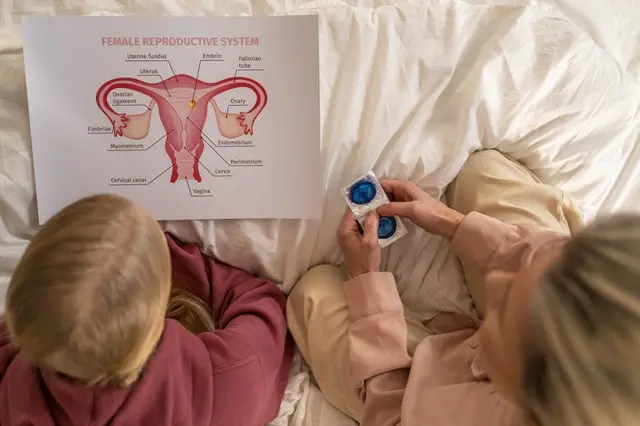Fallopian tube blockage is a common cause of female infertility, affecting millions of women worldwide. When these delicate tubes that connect the ovaries to the uterus become obstructed or damaged, it can prevent the egg and sperm from meeting, resulting in difficulties conceiving naturally.
Recognizing the symptoms of fallopian tube blockage is crucial to seek timely medical intervention and explore appropriate fertility treatments. In this blog, we will explore the signs, symptoms, causes, and potential solutions for this condition.
The Role of Fallopian Tubes in Reproduction
Before delving into the symptoms, let’s understand the role of fallopian tubes in the reproductive process. These slender tubes are approximately four inches long and serve as a crucial pathway for the egg to travel from the ovaries to the uterus. It is in the fallopian tubes where fertilization typically occurs when a sperm meets the egg.
Blocked Fallopian Tube Symptoms
A blocked fallopian tube rarely causes any symptoms in the affected lady.
Often the first sign of a blocked fallopian tube is infertility. If a lady is unable to conceive after one year of unprotected intercourse, they should get evaluated by a specialist.
An infertility specialist may recommend a special X-ray based test to check the fallopian tubes for blockages along with another basic fertility testing.

Hydrosalpinx is a specific kind of blockage of the fallopian tubes which may in certain cases cause lower abdominal pain and unusual vaginal discharge.
However, not every lady encounters these symptoms. A hydrosalpinx is caused when there is a blockage which results in the dilatation of the fallopian tube to fill up the region with fluid.
This fluid-filled blockage prevents the sperm from reaching the egg and causing fertilization.
Blockage in the fallopian tubes due to endometriosis and pelvic inflammatory disease (PID) may cause painful menstruation and sexual intercourse
Symptoms commonly seen in PID:
- General pelvic pain
- Foul-smelling vaginal discharge
- Pain during intercourse
- Fever
- Nausea
- Vomiting
- Severe lower abdominal pain
Blocked Fallopian Tube Causes
The most common causes of tubal blockage is due to pelvic inflammatory disease.
PID is often caused due to an STD (Sexually Transmitted Disease).
In many cases, it has been observed that in the absence of an active pelvic infection, many times a previous infection could still pose a high risk of a blockage.
Other causes of blocked Tubes:
- Current of the previous history of an STD such as Chlamydia or Gonorrhoea
- History of a ruptured appendix
- History of uterine infection due to abortion or miscarriage
- History of abdominal surgery
- History of ectopic pregnancy
- Surgery including fallopian tubes such as tubal ligation
- Endometriosis
Also Read: 7-Step Guide for Overcoming Blocked Fallopian Tubes
Diagnosis of Blocked Fallopian Tubes
Blocked Fallopian tubes are usually diagnosed with a special X-ray test called a hysterosalpingogram, or an HSG Test.
The HSG is a basic fertility test that is recommended to couples facing fertility problems.
The test involves placing an X-ray dye into the cervix using a small tube. Once the dye is taken up, an X-ray is used to examine the pelvic region.
In case of a normal result, the dye travels through the cervix, uterine cavity, and fallopian tubes and spills out around the ovaries into the pelvic cavity.
If the dye is unable to pass through to the ovaries, there could be a possible blockage in the fallopian tube.
Other tests, such as an exploratory laparoscopy, may be recommended to check for blockages in the reproductive tract.
A hysteroscopy involves the use of a hysteroscope, which is a device with a camera inserted into the cervix to image the uterus.
Further blood tests to check for Chlamydia and other STD’s may be suggested to determine the cause of the blockage.
Important Read: What are the chances of getting pregnant with one Fallopian tube
Blocked fallopian tubes treatment
Often if a lady has a single blocked fallopian tube, she may be able to achieve a pregnancy with minimum treatment.
Specialists may prescribe fertility drugs to enhance ovulation on the side of the open fallopian tube.
In case a lady has blockages in both fallopian tubes, the specialist may recommend different options to treat the same.
Laparoscopy Surgery
A laparoscopy surgery may be recommended for blocked fallopian tubes or to remove scar tissue.
The results depend upon the location and severity of the blockage. It also depends on other factors such as the age of the female partner.
Blockages due to a few adhesions between the tube and the ovaries have a good prognosis and usually can be treated to achieve a pregnancy.
Tubal Ligation Reversal
Tubal ligation is one of the methods of permanent birth control. In such cases,
the fallopian tubes are both cut and clamped or a special coil is inserted which prevents the meeting of the sperm and the egg for fertilization.
In certain cases, the ligation is surgically reversible. Surgical reversibility of ligation is usually more successful than repairing a blockage due to an infection.
In- vitro fertilization
In cases where surgery is unable to treat the blockage, IVF technology can be used to help couples achieve a pregnancy.
During an IVF Treatment, the sperm and egg are made to fertilize under laboratory conditions which in turn helps skip the process of the sperm traveling and fertilizing the egg in the fallopian tube.

The embryo formed as a result of the IVF procedure is transferred directly to the uterus and allows a higher rate of success in implantation and pregnancy.
If a lady has a blockage due to a hydrosalpinx, then usually surgery is recommended to remove the same and then an IVF can be conducted.
Read in Hindi – What causes fallopian tubes blockage?




